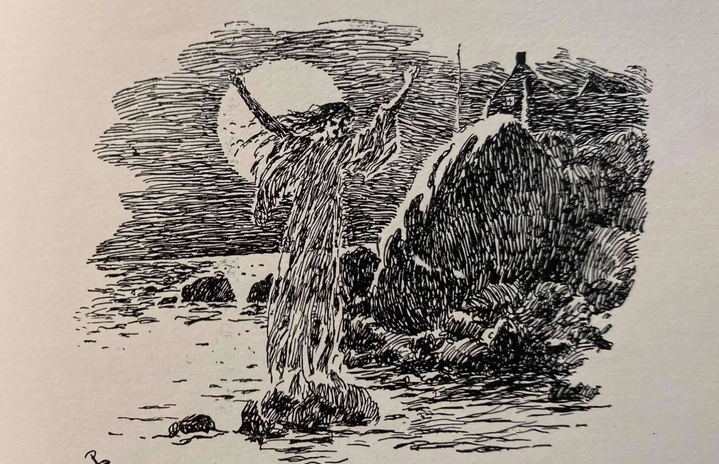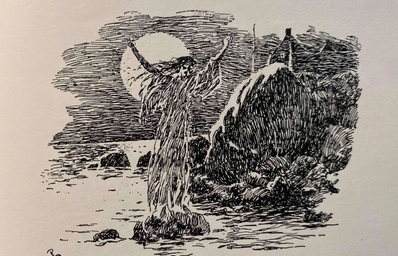In 2023, the term “witch” evokes many associations: crystals, tarot cards, spell books, pointy black hats, and flying broomsticks. Or, you may think of Lana del Rey, Hermione Granger, Halloweentown, and the Sanderson sisters. With #WitchTok attracting billions of viewers on the internet, many women have reclaimed and embraced the historically loaded term as a spiritual expression of feminism, creativity, and empowerment.
From cottage witches to lunar witches, witchcraft is a long-standing tradition perhaps stemming from the worship of Hecate (the goddess of magic and the moon) in Greek mythology. Regardless of its origins, the evolution of witchcraft — and the way the public perceives it — is entangled with racism, patriarchal gender roles, classism, and religious extremism.
witch hunts
Three centuries ago, suspicious behavior resembling “witchcraft” was enough for a person to be convicted and sentenced to death. The Salem Witch Trials were the largest series of witchcraft trials to occur in North America and the last large-scale witch panic in the English colonies. Over the course of 1692, approximately 200 people were jailed for witchcraft. 14 women and five men were hanged, one man was tortured to death, and at least five people died in prison.
Witch hunts were present throughout European history, beginning in the 1300s and dying down in the 1600s. In fact, modern research estimates that 40,000 to 50,000 people were executed as witches in Europe during this time. But why were women in Salem accused of being witches when the European craze was dying down?
the puritans
In 1630, a group of Puritan refugees received a charter for land in New England from the Massachusetts Bay Company. The Puritans sought religious freedom from the Church of England, and they settled north of the Plymouth Colony established ten years earlier. They called themselves the Massachusetts Bay Colony.
Despite seeking religious freedom, the Puritans proved intolerant — determined to preserve their patriarchal, God-fearing belief system. They wanted their colony to be based upon the laws of God and believed God would protect them if they obeyed strict religious laws. In 1630, John Winthrop became the first governor and established a government run by men.
In 1689, England started a war with France in the American colonies for control over the North American continent. The conflict sent many refugees into Salem Village, placing a strain on resources — particularly for families relying on agriculture. Also in 1689, Samuel Parris became Salem Village’s first ordained minister. He gained a reputation for his “rigid ways and greedy nature.” The Puritans interpreted these events as the work of the Devil and pushed for everyone to obey strict religious laws.
Then, in January 1692, Samuel Parris’ daughter Elizabeth (age nine, nicknamed Betty) and niece Abigail Williams (age eleven) began exhibiting strange symptoms. The symptoms included “convulsing, barking, and speaking unintelligible words.” While modern knowledge points to other causes, including boredom, attention-seeking, epilepsy, or eating fungus-infected rye, the doctor examining the girls declared that they were bewitched by someone trying to punish the family.
The ScapeGoat
After the doctor’s pronouncement, Tituba — the enslaved woman owned by Parris who traveled to Salem Village with the family — tried to help the girls. A church member told her to make a “witch cake” to reveal the identity of the person who was tormenting the girls. The recipe involved urine and rye meal. When she was finished, Betty and Abigail revealed that it was Tituba tormenting them — making her the first accused witch.
Not much about Tituba’s life is known to historians. Tituba, likely a Black woman with Indigenous Central American heritage, was bought by Parris in Barbados, where she had been enslaved since childhood. After the girls’ accusation, Parris beat Tituba in an attempt to get her to confess to witchcraft. Tituba denied being a witch and swore she would never harm Betty or Abigail. Parris may have suspected that the young girls were lying but wanted to protect his family’s reputation. Further, the girls were too young to be witnesses in a legal case.
The next month, two women (Ann Putnam and Betty Hubbard) came forward and said that Tituba was using magic to hurt them, with the help of Sarah Good and Sarah Osborne. On March 1, 1692, the first trial began. The accused witches were kept in chains, while the accusers kept “falling into fits and screaming accusations.” Both Sarah Good and Sarah Osborne denied practicing witchcraft, but Sarah Good said she thought Sarah Osborne might be a witch.
The scope of the witch trials changed, however, when the magistrates started questioning Tituba. She provided detailed testimony of serving the Devil, riding on sticks, and talking to animals. She said that Sarah Good and Sarah Osborne forced her to become a witch and hurt the girls. She also spoke of seeing the Devil’s book, complete with the signatures of nine witches in Salem looking to destroy the Puritans.
After Tituba’s confession, the community dissolved into hysteria, and the large-scale witch trials began. Neighbors turned against neighbors, with people accusing others of practicing witchcraft to save themselves. After all, a person who clung to their innocence was executed, while a person who confessed and implicated other witches was spared.
gender roles
It is impossible to talk about the Salem Witch Trials without analyzing gender and its intersection with other identifying factors. Sarah Good and Sarah Osborne both fell outside the standards of acceptable feminine behavior in Puritan society. Women were expected to be virtuous wives — modestly dressed, polite, obedient, and confined to the domestic realm. Gossip, an outlet for oppressed women, was a punishable offense.
By the time of the trials, Sarah Good was a pregnant, homeless beggar considered a nuisance by society. People were quick to testify against Good, citing her cursing and angry mutterings as evidence of witchcraft. Good’s four-year-old daughter was called to give forced testimony against her mother, and this “testimony” led to Good’s conviction. Good gave birth in jail and the infant died before she was hanged.
“I’m no more a witch than you are a wizard! If you take my life away, God will give you blood to drink!”
Sarah Good, 1692
Sarah Osborne was also looked down upon by the community. Osborne was guilty of fornication and was reviled for taking over the estate of her deceased husband, which caused tension with her male children. Further, she had not appeared in church for some time, threatening the strict religious code of the time.
While the marginalization of Osborne and Good is coded with classism, religious intolerance, and gender roles, the scapegoating of Tituba involves power and race. Tituba has been simultaneously sensationalized and villainized for implicating other women to save herself. However, as an enslaved woman of color, Tituba lacked any legal rights or methods of exerting agency in society. Her only representation was Samuel Parris, a white man who beat her many times leading up to the trial. Tituba could not escape her bondage and was thus trapped with an impossible decision. Later on, Tituba actually recanted and told the magistrate that she created the story. While other accused witches were given back their property, along with forms of restitution, Tituba received nothing.
Witchcraft was hung, in History,
Emily Dickinson
But History and I
Find all the Witchcraft that we need
Around us, every Day—
Conclusion
It may seem easy to dismiss the Salem Witch Trials as occurring centuries ago. However, it was only in July 2022 that Elizabeth Johnson Jr. (the last Salem “witch”) was officially pardoned. CNN reported that Carrie LaPierre, an eighth-grade civics teacher in Massachusetts, came across her story. With the help of her students, LaPierre researched the legal steps necessary to clear Johnson Jr.’s name and finally grant her absolution.
The Salem Witch Trials are a crucial part of women’s history that directly correlates with feminism, patriarchy, gender roles, and race. The intolerant, patriarchal society created by the Puritans allowed accusations of witchcraft to become weaponized as tools to get rid of marginalized women — the poor, the old, the strange. And this rhetoric has been repeated and recycled since then. While many women today have reclaimed the title of “witch,” the Salem Witch Trials serve as a chilling reminder of the ways society has not changed since 1692.



